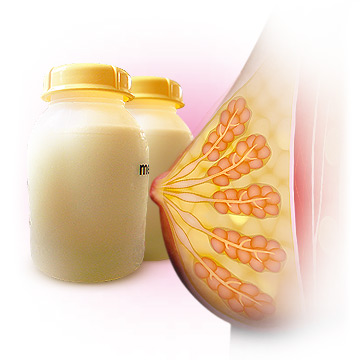All About Breast Milk

Breast milk is a precious commodity, capable of sustaining a newborn's life for at least the first six months after birth, in most cases without the need for supplementation. Learning how it is produced and how it changes can help women master breastfeeding and prevent problems.
Breast Milk Production
A woman will start producing small amounts of breast milk, called colostrum, sometime in the second trimester of pregnancy. When consumed by the newborn, it will provide important nutrients he or she needs in the very first days of life until breast milk production increases around the third day after birth.
How Breastfeeding Works?
Breastfeeding is a supply-and-demand system. As such, the more a mother breastfeeds, the more stimulated her breasts will be to produce more milk. It involves the following processes:
When the baby is suckling on the nipples, it stimulates the nerve endings in the nipple and areola.
A signal is then sent to the pituitary gland to release prolactin and oxytocin.
Their rise signals the alveoli to make milk and the cells around them to contract and push milk through the ducts (“let-down reflex”).
Types of Breast Milk and Their Ingredients
The composition of breast milk is not fixed. It changes constantly to meet the nutritional needs of the developing baby. It generally contains various concentrations of proteins, mainly whey and casein; fats; carbohydrates; and vitamins and minerals.1
Nevertheless, the main three types of breast milk with their distinct characteristics are as follows:2
Type
Characteristics and Ingredients
Day 1-3 after birth
- Usually thick, yellow-orange; called “liquid gold”
- High protein, low fat, maternal antibodies, white blood cells
Day 3-5 until about Day 14
- A combination of colostrum and mature milk
Day 14 onwards
- A combination of foremilk and hindmilk
- Foremilk: thin, watery, lower in fat and carbohydrates
- Hindmilk: thick, creamy, higher in fat and carbohydrates
Breast Milk Storage
Proper breast milk storage is essential for ensuring it is safe and healthy for the baby's consumption. The following are the official milk storage guidelines:3
Refrigerating breast milk prolongs its freshness for up to four days, if it was freshly pumped, or up to one day if it was thawed.
Freezing breast milk prolongs the milk for 6 to 12 months. Previously frozen and thawed milk should never be frozen again.
Continue reading to learn more about breast milk or move to the next section for practical information on how to breastfeed.
How to Breastfeed

Most mothers would agree that getting a hold of breastfeeding takes time and dedication. Luckily, with the right knowledge and breastfeeding essentials, women can master successful nursing and give their babies the best nutrition.
Breastfeeding Methods
Per official breastfeeding guidelines, women are encouraged to practice exclusive breastfeeding for the first six months of the baby's life to then continue nursing while introducing solid foods until at least 12 months of age.4
However, variations are common and possible, giving mothers the following breastfeeding options:
- Exclusive pumping
- Breastfeeding and pumping
- Breastfeeding and formula supplementation
Breastfeeding Positions
For breastfeeding to be successful, two factors are key: proper baby's latch and mother's comfort. While mothers can have their preferred way of nursing their babies, the following breastfeeding positions are the most popular:
- Cradle hold or cross-cradle hold
- Laid-back position
- Football hold
- Side-lying position
Breastfeeding Schedule
In the first one to two months after birth, there is usually no need to create a breastfeeding schedule. Remembering that a newborn should not go without eating for longer than four hours, the mother should be ready to nurse on demand until milk supply is established in the next several weeks.5,6
- First 1-2 months: 8-12 times per 24 hours (day and night)
- Onwards: varies; roughly 7-9 times a day
Breastfeeding Nutrition
While breastfeeding mothers do need well-rounded nutrition to withstand the demands of nursing and give their babies enough nutrients, there is no special diet they should follow. They can ensure proper sustenance with:
- Diet while nursing should be composed of nutritious foods from five groups with 500 extra calories per day.7
- Breastfeeding supplements, such as a multivitamin, can complement, not replace, a well-balanced diet.
Ways to Boost Milk Supply
As babies grow, mothers often worry if they are making enough milk to meet their needs. If the baby is gaining weight properly, a woman's milk supply is adequate. Nevertheless, she can boost her supply naturally with the following tips:
- Increase breastfeeding frequency
- Breastfeed and then pump your breast right after you finish
- Ensure proper nutrition and hydration
- Consider galactagogues supplements, like fenugreek or blessed thistle
Keep reading to learn more information on how to successfully breastfeed or continue to the next section to educate yourself about dealing with common nursing problems.
Breastfeeding Problems

For new and experienced mothers alike, nursing is known to come with some challenges. Fortunately, breastfeeding support is widely available to offer practical guidance and help women face any issues with more ease.
Breastfeeding Complications
Even with the best intentions, breastfeeding complications sometimes arise, putting a physical and emotional strain on the mother. Luckily, most of them can be effectively resolved without affecting a mother's ability to nurse her baby.
The most common breastfeeding complications include the following:
- Low milk supply
- Breast engorgement
- Breastfeeding pain
- Thrush while breastfeeding
- Clogged milk duct
- Mastitis
Breastfeeding Challenges
Since nursing takes a significant portion of a woman's time, it is only natural for certain breastfeeding challenges to appear - especially during the first several weeks - as she is striving to re-organize her daily life around it.
The following are common challenges women might come across as they nurse their babies:
- Breastfeeding in public
- Breastfeeding after C-section
- Nursing while sick
- Breastfeeding while pregnant
- Tandem feeding
- Stopping breastfeeding
Keep on reading for a broader understanding of the most common breastfeeding problems.
Conclusions
Every woman's journey into motherhood is different, and that also includes her unique experiences with breastfeeding her baby. When faced with doubts and moments of weakness, it is important to remember that one's challenges have been shared by thousands of women throughout history. In fact, one of the best ways to find support and encouragement is by asking fellow mothers for practical advice on what worked for them. Equipped with the patience and support they deserve, mothers can take time to find their way through nursing and make it work for them, while giving their babies a truly healthy start in life.
Sources
- American Academy of Pediatrics. (n.d.). Breastfeeding. Retrieved October 3, 2019 from https://www.aap.org/en-us/advocacy-and-policy/aap-health-initiatives/Breastfeeding/Pages/Benefits-of-Breastfeeding.aspx
- American Pregnancy Association. (n.d.). Galactagogues - Boosting Your Milk Supply and Production. Retrieved October 3, 2019 from https://americanpregnancy.org/breastfeeding/galactagogues-boosting-your-milk-supply/
- CDC. (2019). Breastfeeding. Retrieved October 3, 2019 from https://www.cdc.gov/breastfeeding/index.htm
- Eunice Kennedy Shriver National Institute of Child Health and Human Development. (2018). What are the benefits of breastfeeding? Retrieved October 3, 2019 from https://www.nichd.nih.gov/health/topics/breastfeeding/conditioninfo/benefits
- Healthy Children. (n.d.). Breastfeeding. Retrieved October 3, 2019 from https://www.healthychildren.org/English/ages-stages/baby/breastfeeding/Pages/default.aspx
- Medline Plus. (2019). Breastfeeding. Retrieved October 3, 2019 from https://medlineplus.gov/breastfeeding.html
- Obstetrics & Gynecology. (2009). The Risks of Not Breastfeeding for Mothers and Infants. Retrieved October 3, 2019 from https://www.ncbi.nlm.nih.gov/pmc/articles/PMC2812877/
- Office on Women's Health. (2019). Breastfeeding. Retrieved October 3, 2019 from https://www.womenshealth.gov/breastfeeding
- Office on Women's Health. (n.d.). Your guide to breastfeeding. Retrieved October 3, 2019 from https://www.womenshealth.gov/files/documents/your-guide-to-breastfeeding.pdf
- Stanford Medicine. (2016). Getting Started with Breastfeeding. Retrieved October 3, 2019 from https://med.stanford.edu/newborns/professional-education/breastfeeding.html
Footnotes:
- American Pregnancy Association. (2019. What's in Breast Milk? Retrieved October 3, 2019 from https://americanpregnancy.org/first-year-of-life/whats-in-breastmilk/
- Pediatric Clinics of North America. (2013). Human Milk Composition: Nutrients and Bioactive Factors. Retrieved October 3, 2019 from https://www.sciencedirect.com/science/article/pii/S0031395512001678?via%3Dihub
- CDC. (2019). Proper Storage and Preparation of Breast Milk. Retrieved October 3, 2019 from https://www.cdc.gov/breastfeeding/recommendations/handling_breastmilk.htm
- American Academy of Pediatrics. (2012). AAP Reaffirms Breastfeeding Guidelines. Retrieved October 3, 2019 from https://www.aap.org/en-us/about-the-aap/aap-press-room/Pages/AAP-Reaffirms-Breastfeeding-Guidelines.aspx
- La Leche League International. (n.d.). Frequency of Feeding. Retrieved October 3, 2019 from https://www.llli.org/breastfeeding-info/frequency-feeding-frequently-asked-questions-faqs/
- Kids Health. (2015). Breastfeeding FAQs: How Much and How Often. Retrieved October 3, 2019 from https://kidshealth.org/en/parents/breastfeed-often.html
- Eunice Kennedy Shriver National Institute of Child Health and Human Development. (2017). When breastfeeding, how many calories should moms and babies consume? Retrieved October 3, 2019 from https://www.nichd.nih.gov/health/topics/breastfeeding/conditioninfo/calories
